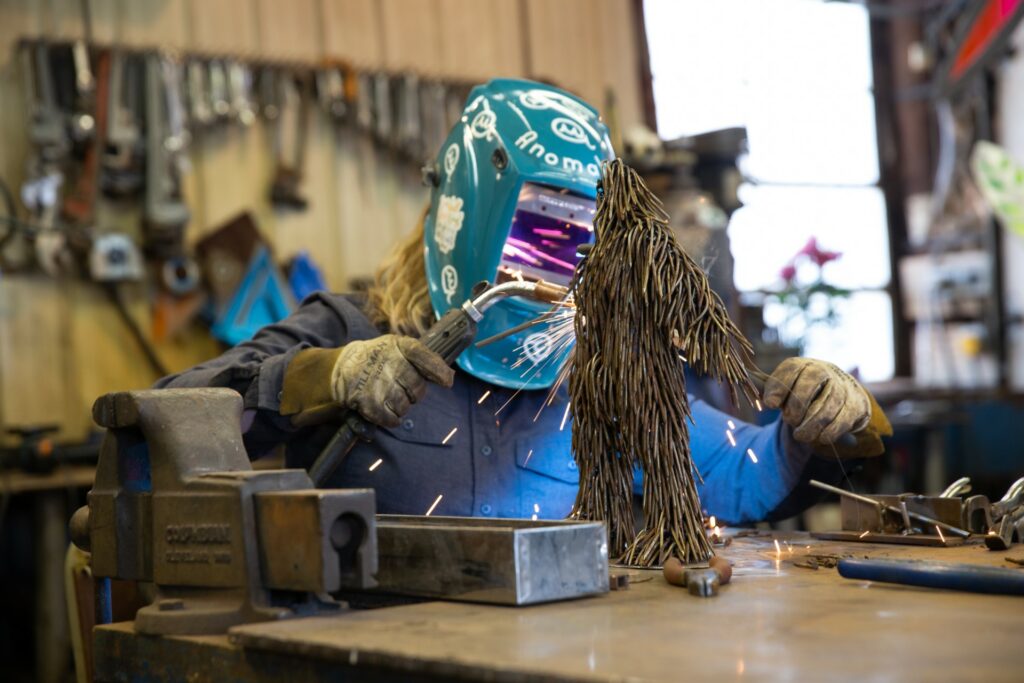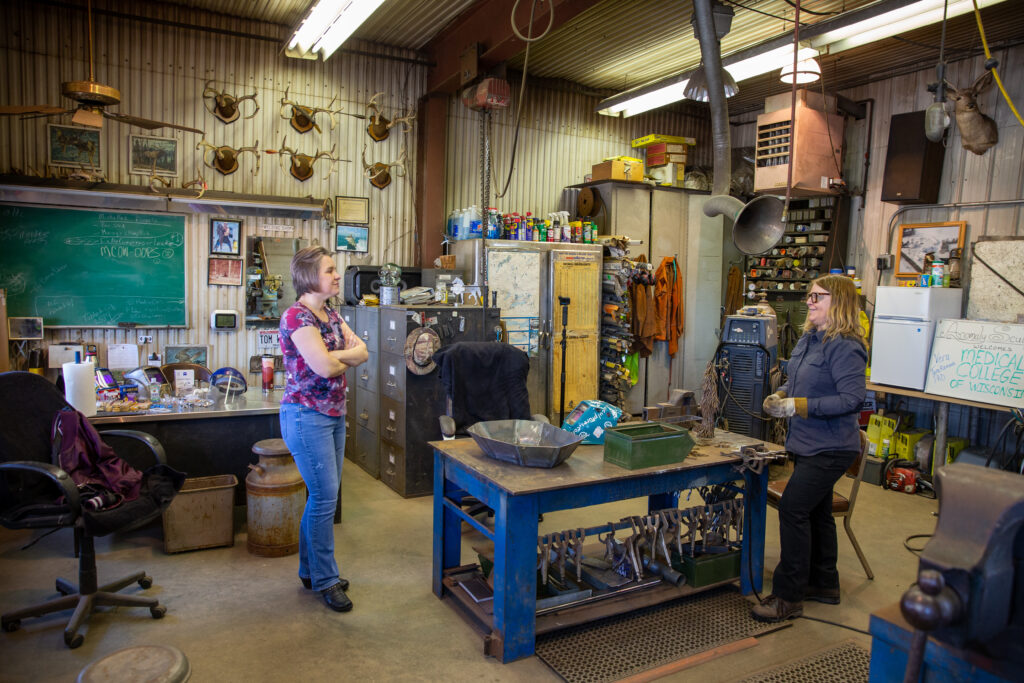During the COVID-19 pandemic, Michelle Anomaly, a Wisconsin-based artist and the owner of Anomaly Sculptures, found herself frustrated with the forced disconnect between people. As a way of working through her emotions, Anomaly searched for a way to express them through art.
Anomaly found it in framing, roofing and finishing nails, which she turned into the spikes of a basketball-sized version of a coronavirus cell in a sculpture called “The Cell” in 2022. It looks like a torn open virus cell with a single chair made from nails in the center. She says it isn’t a piece of art that was meant to be appealing to the eye. Anomaly had a hard time imagining anyone wanting it, but her husband suggested she consider clients in the medical field.
“I had never thought of the medical field as being a client, but I really liked the idea because I’ve also always had a strong curiosity about how our bodies work,” Anomaly wrote in an email.
Anomaly didn’t realize that the chance encounter with scientific knowledge in “The Cell” would lead to more possibilities for her artwork to fuse with science through Project Wonder, an initiative of the Medical College of Wisconsin.

Launched in March 2022, Project Wonder unites medical researchers with local artists, reshaping the landscape of scientific discovery through creative expression. Scientists, like artists, need to tap into immense creativity, think outside the box and find novel approaches to their work, says Alex Boyes, the senior creative consultant and project lead for Project Wonder at the Medical College of Wisconsin.
The leadership at the Medical College of Wisconsin recognized this synergy and, following fruitful discussions, decided to embark on this journey to fuse science and art, Boyes says. Project Wonder has fostered an array of captivating art forms to showcase innovative research, including but not limited to paintings, sculptures and graphic designs.
Nan Li, an assistant professor in the life sciences communication department at UW–Madison, recognizes the importance of visual representations of medicine in science communication and says it can lead audiences to reflect more on a topic.
“For the general audience, learning that this is something that resonates with the artist and seeing this science through the artistic eye will really give a fresh perspective to lay audiences to motivate them to learn more,” Li says.
Combining metal and glass
When Anomaly was a child, she used to spend her afternoons with her grandmother sewing fabric into whimsical stuffed animals. This childhood activity unknowingly planted the seeds of artistic enlightenment in Anomaly’s mind. As she grew as an artist, Anomaly was exposed to many different media other than fabric, and she was always quick to find commonalities between them.
Anomaly is most comfortable using metal. Influenced by her father and other family members, she attempted her first weld around the age of 13. As she attended college, she became a part-time welder for her father’s welding business, learning in more detail the art of what she calls sewing with fire.
Perhaps the most extraordinary twist in Anomaly’s artistic evolution came with the discovery of stained glass. At first glance, the juxtaposition of metal and glass appeared incongruous — one unyielding and unbreakable while the other fragile and transparent. But for Anomaly, this incongruity made them an interesting combination.
“When you’ve got something like metal or glass, it has to be done exact. If it’s not exact, it’s just not forgiving like a lot of other media. I like having that challenge,” Anomaly says. “I’m so surprised now that I’ve gone through the process at least a couple times, I think it’s just the perfect match.”
Connecting the artist and the scientist
Anomaly stumbled upon Project Wonder while trying to find a buyer in the medical field for “The Cell.”
Boyes saw the sculpture, and though they did not discuss a sale, he had the idea to connect the artist with Vera Tarakanova, a professor in the microbiology and immunology department at the college. He says that Tarakanova’s creative nature makes her an ideal candidate for collaboration on a project that requires innovative, out-of-the-box thinking.
“Here’s a sculptor who’s already shown an affinity for sculpting, and here’s a researcher who is great with metaphors,” Boyes says about setting up a conversation between Anomaly and Tarakanova to discuss an approach for communicating her research to a broad audience.

This was how Anomaly and Tarakanova began a collaboration to depict the Epstein-Barr virus, which is one of the most common viruses in humans. Their partnership epitomizes the fusion of creativity and research, much like the marriage of glass and metal in Anomaly’s sculpting endeavors.
“I had not worked with scientists or researchers previously, but I feel it is a natural match,” Anomaly wrote in an email. “A scientist or researcher has a similar process. They also start with ideas, move forward with experiments and eventually come to a result — hopefully!”
However, trying to understand what took researchers years to comprehend is not easy. Because there is so much involved in Tarakanova’s research, Anomaly, who knew very little about the Epstein-Barr virus, had a hard time at first trying to come up with a prototype design to represent it. She began to read up on the subject herself, but this only brought her more confusion.
Anomaly was unwilling to succumb to that confusion — she was determined to create an accurate and meaningful artistic representation. The solution lies in direct communication with Tarakanova, a bridge of understanding between art and science. The insightful exchange of questions and explanations allowed Anomaly to refine the ideas that had been burgeoning within her.
“It wasn’t until I spoke with Dr. Tarakanova herself that I felt like I was moving leaps and bounds to understanding it at the level that I needed to,” Anomaly says. “She’s so kind and patient with my questions, and she’s a great teacher. I feel really blessed that I was able to interact with her on this project and get to know her and her research.”
With a newfound clarity and a more profound comprehension of the Epstein-Barr virus, Anomaly narrows down the artistic concepts and translates them into detailed visual representations. Her extensive communication with Tarakanova and the Project Wonder team facilitates the selection of a definitive plan. With this blueprint in hand, Anomaly embarks on the arduous yet immensely rewarding task of bringing her artistic vision to life.
Fusing art and science
The Epstein-Barr virus resides in approximately 95% of individuals, and it has the unique ability to establish a long-term refuge within specific cells of the human immune system that are known as B cells. While dormant, the Epstein-Barr virus usually remains harmless like a passive passenger on a train.
However, for some, this seemingly dormant virus can cause serious health issues, including certain cancers. Tarakanova’s research uses an animal virus closely related to the Epstein-Barr virus to understand how the virus is controlled during lifelong infection since increased virus activity can lead to virus-driven cancer.
“I wanted people to wonder and ask questions about what was happening to my sculpture, the same way I want people to wonder and ask questions about Dr. Tarakanova’s research,” Anomaly wrote in an email.
In her art, a Sasquatch symbolizing the Epstein-Barr virus occupies a glass house in the form of a memory B cell. The rusty nails representing its fur allude to the spike proteins on the virus’s surface. The Sasquatch, initially appearing harmless, is shown to potentially inflict damage upon the glass house, leaving viewers with a sense of uncertainty about whether the harm was deliberate or merely collateral.
“Anomaly not only got the concepts we discussed, but her incredible intuition and talent has translated those into a really cool piece of art,” Tarakanova wrote in an email. “I am very lucky to have her sculpture at [the Medical College of Wisconsin] so that I can send our graduate students to visit it and learn to appreciate that creativity is critical for the success of their research.”
Anomaly also puts her creativity to use in the naming of the sculpture. To add some lightheartedness to a sculpture that may be a bit uncomfortable in nature, she explains the origin of the name “Oops!” through an imaginative scenario.
“We can clearly see that [the Sasquatch] has caused damage to its home. Why? Is it just too big and clumsy to live in its glass house? Maybe it likes to dance on occasion and, this last time, it spun around and — with an ‘Oops!’ — poked a hole in the wall,” Anomaly said in the artist’s statement. “Or maybe it is a cranky creature and keeps taking its frustrations out on its surroundings.”
When the sculpture was finalized and transported to the Medical College of Wisconsin, Anomaly felt a curious mix of emotions. She likens the experience of working on a project like this to giving birth since the idea took time to develop, and she didn’t know what it would look like until it was complete. Anomaly’s journey into the realm of the Epstein-Barr virus through Project Wonder had left her with enthusiasm for further forays into the intersection of art and science.
“I learned so much in the process, and it got me thinking about the way our DNA works,” Anomaly wrote in an email. “I’ve already designed a sculpture about our DNA. Now I just have to figure out how to bring it to reality!”
